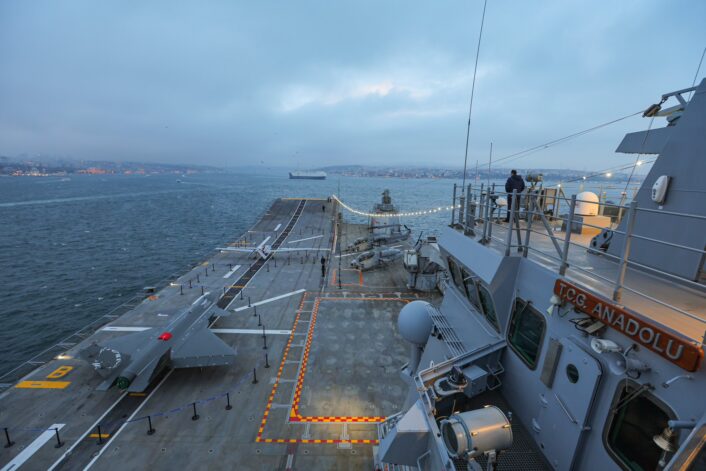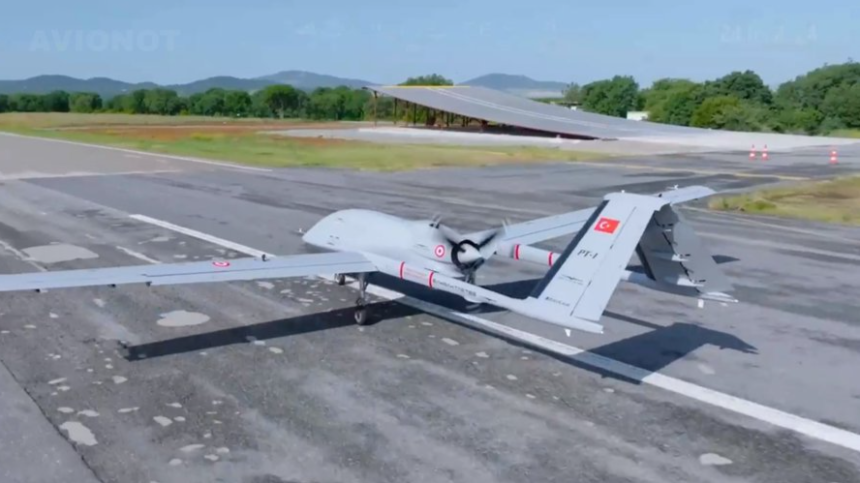A naval version of the TB2 which can take off from short runways and has foldable wings, the TB3 would become the first UCAV to operate from the TCG Anadolu LHD.
Turkey’s Bayraktar TB-3 UCAV (Unmanned Combat Aerial Vehicle)/reconnaissance-strike drone will perform operations from a land-based runway with a ski-jump, before it flies off the specialized drone carrier and amphibious landing ship, TCG Anadolu.
Images, videos released on defense forums and Turkish defense industry handles show the TB3 taking off and landing from an air base, where another runway with a ski-jump towards the end is also seen. The videos don’t show the UCAV taking off from the STOBAR (Short Take-Off Barrier-Arrested).
The framing in the posts says this is set to happen soon. “The ramp where Bayraktar TB3 UAV will perform landing and take-off tests before TCG ANADOLU,” said THS Savunmma.
The development comes after Selçuk Bayraktar, Baykar’s Chairperson and CTO (Chief Technology Officer), previously announced that the company plans to test the Bayraktar TB3 aboard TCG Anadolu in 2024.
Here is the ramp where Turkish Bayraktar TB3 UAV will perform its landing and takeoff tests.
Bayraktar TB3 UAV will be able to take off and land from the 12-degree flight ramp of Turkish Navy’s TCG ANADOLU ship.
TCG ANADOLU will be the world’s first UCAV carrier. pic.twitter.com/p8j2KWtbBT
— Clash Report (@clashreport) May 24, 2024
Navalized & Advanced Version of the TB2
A follow-on of the famous TB2 that took center stage in the early months of the war in Ukraine and the September 2020 Nagorno-Karabakh conflict, the TB3 has foldable wings to operate off the Anadolu. It has been specifically described as a “short runway capable version” of the TB2. This makes it the “first UCAV capable of operating from short-runway ships like the TCG Anadolu.”
It made its first flight on October 27, 2023, successfully performing the High Altitude System Performance Test. As of early-May, it has logged 327 hours and 35 minutes in test flights, including a 32-hour continuous flight covering 5,700 kilometers (3,541 miles) on December 20 last year. It also holds the altitude record in Turkish aviation after it touched 45,118-feet. This puts it firmly in the MALE (Medium-Altitude Long-Endurance) category of drones.
On March 26, 2024, it flew with a domestically-developed ASELFLIR-500 engine, set to eventually replace the UKrainian-origin PD-170 power plant it presently flies with.
The description of its features and capabilities in the Turkish media are evident of the TB3 being a primarily reconnaissance-strike platform, with “BLOS (Beyond-Line-Of-Sight) communications” for long-endurance surveillance “intelligence and attack missions” to “significantly” enhance Turkey’s “deterrent capabilities.”
But the development and rapid operationalization of the TB3 also should be seen in the light of Turkey particularly focusing on a UCAV-centric carrier air wing capable, with few manned fighters. Effectively, beside the existing amphibious LHD (Landing Helicopter Dock) TCG Anadolu which is a drone carrier, even its future planned carrier would be mainly operating UCAVs. This will be expanded upon subsequently.

TCG Anadolu
The TCG Anadolu is the largest warship in the Turkish fleet, its flagship and also the world’s “first” vessel with an air wing mainly consisting of unmanned aircraft, according to Daily Sabah. Based on Spain’s flagship, the Juan Carlos I, the TCG Anadolu is a LHD type amphibious assault ship. It is 231-meters (758-feet) long, 32-meters wide with a displacement of 27,436-tons. It has a top speed of around 21-knots, a range of 9,000-nautical miles, and can operate at sea for 50 days.
The ship was ordered in 2015, laid down in February 2018, launched in April 2019, and commissioned in April 2023. The Anadolu is intended to undertake “sustaining long-endurance, long-distance military combat, or humanitarian relief operations while acting as a command center and flagship for the Turkish Navy.”
Beside the TB3, it is also expected to also operate the Kizilelma, another one of Baykar’s unmanned combat aerial vehicles (UCAV). Turkish reports also describe it as the “unmanned fighter jet.”
New Carrier
In April 2024, DDPO (Turkey’s Directorate of Design Project Office) revealed plans for a larger carrier which would be 285-meters in length, with a displacement of 60,000-tons, powered by a COGAG (Combined Gas and Gas) propulsion that push it speeds of 25-knots.
While officially released images showed a STOBAR configuration, Turkish engineers plan to “design” a “modular flight deck” to “allow for the installation of a catapult in the future.” The aircraft carrier is set to include three runways, with two designated for takeoff and one for landing. The computer-generated concept images showed the proposed carrier carrying the HÜRJET Light Combat Aircraft and the ANKA-3 as well – beside the TB2, TB3 and KIZILELMA.









